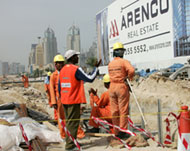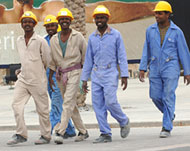Workers’ misery belies Dubai’s glitter
Beyond Dubai’s shimmering skyscrapers lies Sonapur, a crowded and rundown camp for Asian labourers toiling on the city’s monumental projects.

Sonapur, or the golden place in Hindi, once a burial ground, is now a collection of tenements housing more than 150,000 workers, mostly Indians and Pakistanis, according to a UAE-based Indian community organisation.
Ghulam Mustafa, 35, stands at the entrance of one 35-room compound where he and some 600 other migrant workers live in this desolate desert area on Dubai’s fringe.
“Welcome to the damaged camp,” he says.
Past a battered metal gate painted orange, dozens of men sit around a courtyard littered with broken furniture and piles of garbage bags.
The one-storey structure resembles a school with rooms measuring 3.6 metres lining a dank and poorly-lit corridor.
Food is cooked on gas stoves attached to propane cylinders.
Little to save
Niaz Hussein, 24, shares one room with 14 others, most of whom sleep on the floor since there are only two bunk beds inside.
The native of Pakistan’s impoverished southeastern Sindh province has been in Dubai for 13 months trying to squeeze a living from odd construction jobs to support his wife and daughter and elderly parents back home.
He earns four dirhams (1.10 dollars) an hour.
 |
|
Some workers at construction |
If he is lucky, he can make about one thousand dirhams (274 dollars) a month, out of which he has to spend 342 dirhams on food and rent and pay back the fees charged by the recruiting agency that brought him to Dubai and arranged for his work permit.
Those fees can be as high as 12,000 dirhams.
Hussein is working on a road construction project but has not been paid for more than a month.
“It is unbearable, I keep thinking how my family is coping,” he said wearing stained blue shalwar, Pakistan’s traditional male dress.
Riots
The plight of Asian labourers in the United Arab Emirates, the seven-emirate federation that includes booming Dubai, came into focus again on March 21 when 2,500 rioted at the construction site of Burj Dubai, slated to be the world’s tallest skyscraper.
Some destroyed vehicles and equipment.
 |
|
Indians and Pakistanis make up |
Their employer, a British-UAE joint venture called Al-Naboodah Laing O’Rourke, blamed the incident on “misinformation and misunderstanding”, adding that the issue had been resolved.
Burj Dubai’s owner, Emaar, the real-estate powerhouse controlled by the Dubai government, was swift to issue a terse statement that the incident had nothing to do with the tower and that work there was uninterrupted.
Close to 50 contractors and subcontractors are involved in the project, one of several high profile developments aimed at transforming Dubai into a world capital attracting 15 million visitors by 2010.
It is already the oil-rich Gulf’s commercial hub.
“Live the life,” a big blue Emaar billboard at the project site reads depicting Westerners laughing and feeding each other with chopsticks.
Regular complaints
The Indian consulate’s labour and welfare consul, BS Mubarak, said he gets at least 10 complaints a month mostly related to unpaid and late wages and that the incident at Burj Dubai may have been sparked by the long queues that workers have to endure to punch their timecards.
Indians and Pakistanis make up nearly 45% of the UAE’s population of about four million.
Emiratis account for only 20%.
The riot prompted the New York-based Human Rights Watch (HRW) to issue a statement on March 30 calling on the UAE government to “end abusive labour practices” describing labour conditions as “less than human”.
Ali al-Kaabi, the labour minister, called the statement “insane and illogical”.
Previous protests
Labour trouble is not new to Dubai.
In September, hundreds of workers walked off the Palm Jumeirah project, a man-made island off Dubai’s coast, protesting unpaid wages.
They blocked a major highway for hours.
|
“The blue-collar workers are the last link in the chain so they are the worst affected. They have all come with lots of hopes and commitments from back home … “ K KumarIndian Community Welfare Committee |
No day goes by without a story in the local papers about labour woes and even Hollywood thriller Syriana has a few scenes about the hardship of Asian labourers in the Gulf.
The movie, partly shot in Dubai in 2004, will be shown in the UAE starting April 12 with these scenes censored, according to the distributor.
K Kumar, 57, the head of the Indian Community Welfare Committee, told AFP that “the problem is very serious.”
More attention
“If you want to keep the situation under control, they (government) have to give more attention to these issues,” Kumar added.
Trouble often begins when subcontractors run into financial difficulties or are not paid on time because of delays in getting their work certified by main contractors on a project.
“The blue-collar workers are the last link in the chain so they are the worst affected,” Kumar said.
“They have all come with lots of hopes and commitments from back home … when they are stuck and find it so difficult even for their own survival obviously frustration sets in.”